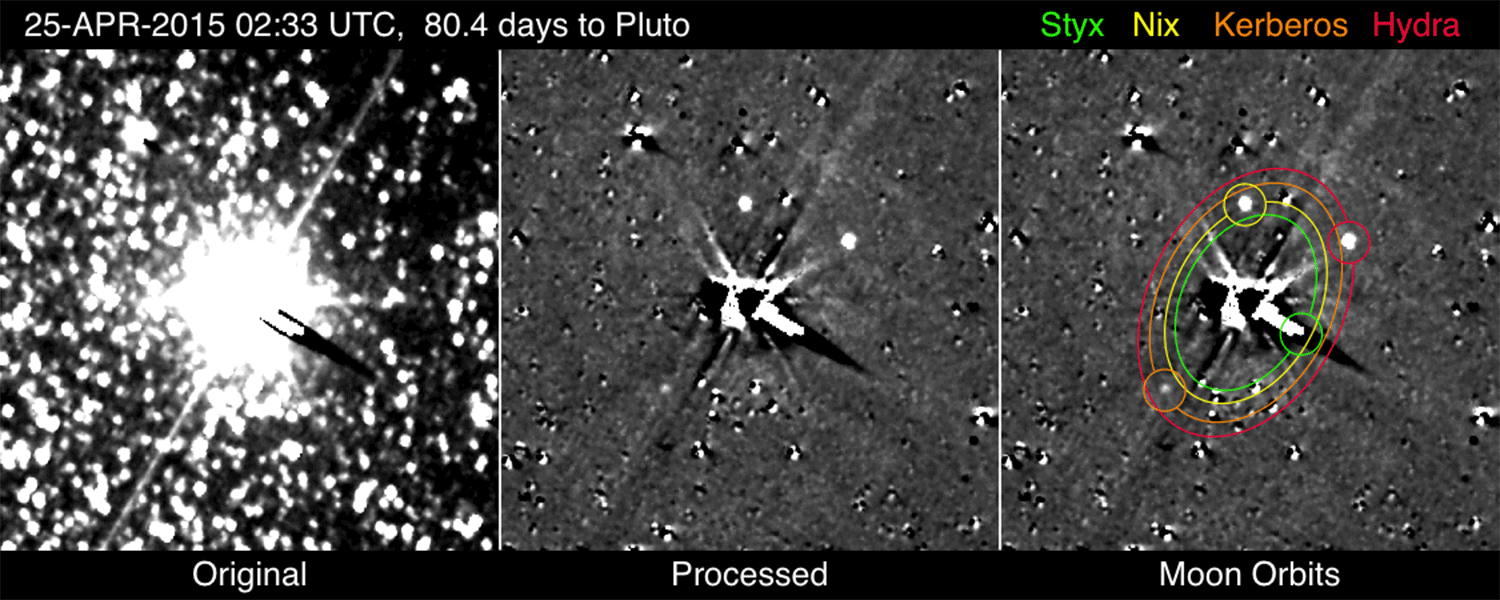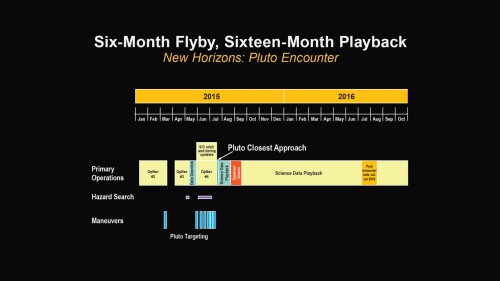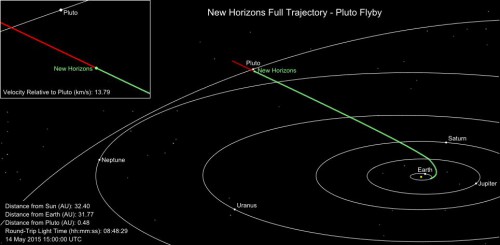
At left is the initial set of raw images, while at the center are the same images that have been extensivelly processed in order for the tiny moonlets to become visible amidst the bright glare of Pluto and Charon. The orbits of all of Pluto’s known moons except Charon, are shown at right. Image Credit: NASA/Johns Hopkins University Applied Physics Laboratory/Southwest Research Institute
Speeding through the interplanetary abyss at record speed, NASA’s New Horizons spacecraft is, as of today, exactly two months away from its much-anticipated close fly by of Pluto. Despite the large distance of many millions of km that still separate it from its ultimate destination, New Horizons was nevertheless able to image Pluto’s two smallest known moons, Kerberos and Styx, for the first time, thus completing the first long-range photographic reconnaissance of the dwarf planet’s entire satellite system.
This year, has been rightfully described as the year of the dwarf planets. With NASA’s ongoing Dawn mission already returning spectacular close-up images from Ceres in the asteroid belt between Mars and Jupiter, the family of ‘minor’ planetary bodies in our Solar System is bound to provide major scientific results as well as great excitement throughout the year for scientists and non-scientists alike. In another part of the Solar System, the New Horizon mission is in the final lap of its 9-year voyage to the distant dwarf planet Pluto and its moons. Almost a decade after it was launched in 2006 and an epic trek of 4.5 billion km through the entirety of the Solar System, the spacecraft finally entered the realm of the mysterious and utterly unexplored Kuiper Belt when it crossed the orbit of Neptune last August. Yet, the intrepid robotic explorer had to wait for a few months still, before being re-awakened from its long electronic hibernation for the last time this January. This final wake-up call marked the historic start of the mission’s long-range reconnaissance of the Pluto system, that will culminate with the spacecraft’s long-awaited close fly by of the distant world in 14 July.

This long-range reconnaissance has been divided by the mission’s science team into three smaller phases, called Approach Phases 1, 2 and 3 respectively. Each phase is characterised by its own unique set of observations and science objectives, which provide essential and very important science and engineering data to the mission’s ground teams at the Johns Hopkins University Applied Physics Laboratory (APL) in Laurel, MD, as New Horizons makes its way to the point of closest approach this summer. During Approach Phase 1, which lasted from Jan. 15 to Apr. 4, was mainly dedicated to science measurements of the background interplanetary dust environment in the vicinity of the Pluto system as well as providing images of the distant planet, as part of a critical optical navigation campaign that was designed to help ground controllers to accurately determine the exact position of Pluto against the fixed background stars. During that time, New Horizons returned its exciting first long-range images of both Pluto and its largest moon Charon, showing them gracefully revolving around each other in an intricate gravitational dance that could best be described as that of a double planetary system than a planet and its moon. Not to be outdone, two of Pluto’s smaller moons, Nix and Hydra, jumped into the spotlight as well, while being spotted by the spacecraft’s cameras for the first time as they serenely revolved around the planet.
As Approach Phase 2 kicked in on April 5, New Horizons added further science observations into its daily schedule, while also undertaking a wide optical survey of the entire Pluto system in the process. Even though Pluto had been excluded from the group of the Solar System’s ‘major’ planets soon after the launch of New Horizons, the latter’s observations during the still ongoing Approach Phase 2 have shown that there’s definitely nothing small and insignificant about this mysterious, world at the far reaches of the Solar System. A series of images that were taken by New Horizons in mid-April, have revealed some exciting bright surface features on the still-distant Pluto that could be indicative of extensive polar ice caps. If confirmed, this would be a truly fascinating discovery that would make Pluto unique among the other planetary bodies of the outer Solar System. “There are big albedo, or reflectivity spots, on Pluto [seen in these images], bright spots and dark spots,” said Alan Stern, principal investigator for New Horizons at the Southwest Research Institute in Boulder, Colo., during a radio interview for the Planetary Society earlier this week. “If they were on the Earth, they would be called ‘continent-sized’. Now, the interesting thing is, if you compare those images that New Horizons just released to very low-resolution images of other planets (Venus, or Mars, or Mercury for example), you wouldn’t find anything like this. Pluto’s surface seems to have a much more interesting character at low resolution than most places and that bodes very well for what we’ll see at high resolution in just a few weeks.”

Despite the fact that Pluto still currently appears as just a bright dot in the distance no more than a few pixels wide, New Horizons was nevertheless able to capture the images of its two smallest moons, Kerberos and Styx during the last week of April, from a distance of approximately 90 million km away. With a diameter roughly between 10 and 30 km, these inconspicuous moons, which were only discovered with the help of the powerful Hubble Space Telescope in 2011 and 2012 respectively, are some of the smallest in the entire Solar System, exhibiting an absolute brightness that is more than 20 times lower than that of the slightly larger Nix and Hydra, two of Pluto’s other known miniature moons. New Horizon’s images of Kerberos and Styx stretched the capabilities of the spacecraft’s onboard Long Range Reconnaissance Imager, or LORRI, to the limit, and were extensively processed in order for the tiny moonlets to become visible at all amidst the bright glare of Pluto and Charon, as well as that from the background fixed stars. Apart from their scientific value regarding Nix and Hydra themselves, these images will also be of great interest to the mission science team in its hunt for even more moons around Pluto that may have gone undetected so far, as well as any dark rings that may orbit the planet itself that could potentially become a hazard to the spacecraft as it hurtles through the Pluto system in the coming weeks. “New Horizons is now on the threshold of discovery,” says John Spencer, a mission science team member at the Southwest Research Institute in Boulder, Co.. “If the spacecraft observes any additional moons as we get closer to Pluto, they will be worlds that no one has ever seen before.” “Detecting these tiny moons from a distance of over 55 million miles is amazing, and a credit to the team that built our LORRI long-range camera and John Spencer’s team of moon and ring hunters,” adds Stern.
As scientifically productive as the mission’s Approach Phase 2 has been so far, it will be greatly surpassed by the upcoming Approach Phase 3, which begins on June 23 and will last until time of the Pluto fly by on 14 July. By the time Approach Phase 2 ends however, New Horizons will have already began to return high-resolution images of the entire Pluto system that will only get better with each passing day. “As we begin to draw close to the [Pluto] system in June and throughout the month of July, the spacecraft will be training all the remote sensing instruments and the in-situ instruments as well on the Pluto system in making not just daily observations, but as we get close we’ll have three times per day imaging sweeps and then in addition once we’re right on top of it in the days right around closest approach, the spacecraft will be making observations essentially around the clock,” says Stern.
After a voyage of more than 9 years through interplanetary space, the time has finally come for NASA’s New Horizons mission, which had already been more than 20 years in the making, to start providing humanity with its first detailed views in the next several weeks, of the largest member of the Kuiper Belt in the uncharted depths of the outer Solar System. “In a [timeframe] of well less than a lifetime (just 50 years since the first Mariner probes were dispatched) the NASA planetary science program has been first to every planet in the Solar System, as well as making big strides in terms of studies of small bodies like comets and asteroids,” comments Stern. “It’s really something that I think the United States will go down in history for ever for”.
Want to keep up-to-date with all things space? Be sure to “Like” AmericaSpace on Facebook and follow us on Twitter: @AmericaSpace
Missions » New Horizons »



This is interesting though I wish they had put the spacecraft in orbit but I now understand that they are looking for two massive object somewhere further out there at a MASS of 10XEarth.
No way they could have slowed it down to hang around the Pluto system after making it go so fast. I would have made it a far larger vehicle. The rocket equation is merciless.
We are being treated to an absolutely incredible series of images from both Mars and Pluto. Ken’s and Leonidas’s articles point to planetary exploration which should excite each and every one of us. I sound like “Johnny One-Note” when I continue to say, among other things, that the “chump change” we are spending for such valuable scientific information is cheap at twice the price. We must leave a lasting legacy to future generations that we, in the 20th and 21st centuries, set the standard of scientific inquiry for planetary and deep space exploration. Listen to us, Congress! We can’t afford not to continue such funding that will ultimately benefit all of mankind.
The NewSpace community is all about going cheap- and they scream cheap endlessly in pursuit of making their LEO tourist business plan a reality. That the NASA budget must never go up is dogma for them because this limitation supports their hobby rocket taking lego blocks and a couple gallons of gas at a time into the dead end of LEO agenda.
These probes are a dilemma for me because I want to see human beings established beyond Earth orbit- on the Moon as a first step. As space advocates we are all hopelessly divided into separate camps wanting our own interest funded and thus don’t stand a chance competing for funds with the DOD. Incredibly frustrating. The best plan I have come up with tries to make all the difficulties work for us:
https://iceonthemoon.wordpress.com/2015/02/03/seven-steps-to-space-travel/